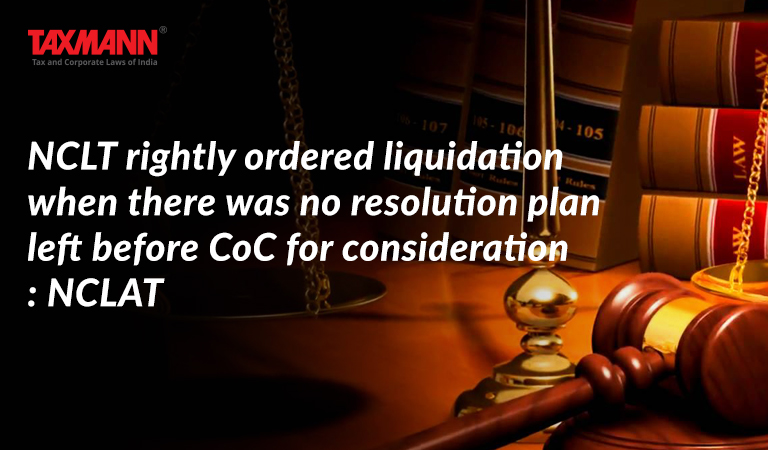NCLT rightly ordered liquidation when there was no resolution plan left before CoC for consideration: NCLAT
- Blog|News|Insolvency and Bankruptcy Code|
- 2 Min Read
- By Taxmann
- |
- Last Updated on 17 October, 2022
Case Details: C.E. Fernandes v. Naveen Sood, Resolution Professional For GEI Industrial Systems Ltd. - [2022] 142 taxmann.com 551 (NCLAT-New Delhi)
Judiciary and Counsel Details
-
- Rakesh Kumar Jain, Judicial Member Dr Alok Srivastava & Barun Mitra, Technical Member
- Davesh Bhatia, Adv. for the Appellant.
- Naveen Sood, Ms Anushree Kapadia, Gaurav Mathur & Ms Anvi Majumdar, Advs. for the Respondent.
Facts of the Case
In the instant case, the Corporate Insolvency Resolution Process (CIRP) was initiated against the corporate debtor and the Resolution Professional (RP) was appointed. The promoter of the corporate debtor (hereinafter referred to as the “Appellant”) submitted that the resolution plan was not considered by the CoC on the ground that the corporate debtor was not an MSME and therefore Ineligible to submit resolution plan u/s 29A of the IBC.
“As per the provisions of section 240 A of the Insolvency and Bankruptcy Code, 2016 in case of the corporate debtor being an MSME, the promoter of the Corporate Debtor shall be eligible to submit a resolution plan which is otherwise prohibited under section 29A of the Insolvency and Bankruptcy Code, 2016.”
Aggrieved by the action of the CoC, the appellant filed an application before the Adjudicating Authority (NCLT) seeking to provide clarity regarding MSME status. The NCLT directed the RP/CoC to re-examine the issue of the MSME status of the corporate debtor.
Thereafter, the corporate debtor was considered eligible to be classified as MSME by RP. Thereafter, the appellant submitted its modified resolution plan and the proposed resolution plan was put it for electronic voting, whereby the resolution plan was rejected with a voting share of 70.60 %. Later on, the appellant vide e-mail withdrew its proposed resolution plan and the CoC decided to go for corporate debtor’s liquidation.
Then, an appeal was made to the National Company Law Appellate Tribunal (NCLAT) against the order passed by the NCLT.
The appellant submitted that the CoC did not look at the appellant’s proposed resolution plan with any seriousness, which caused serious prejudice in consideration of the resolution plan submitted by him, and thus the matter of the MSME status of the corporate debtor should have been decided by the NCLT rather than leaving it in the hands of the CoC/ resolution professional.
NCLAT Held
The NCLAT observed that the CoC, without any prejudice regarding the eligibility of the appellant under section 29A, did consider the resolution plan submitted by the appellant and offered suggestions for its modifications/improvements. Further, sufficient opportunity had been given to the appellant to present a feasible and viable resolution plan. However, he eventually failed and withdrew its proposed plan.
The NCLAT held that since no resolution plan was left before CoC for consideration, and almost three years had elapsed from the initiation of the CIRP, thus the provisions of section 33 came into play and were duly considered by the Adjudicating Authority for ordering liquidation. Therefore, the instant appeal was to be dismissed.
List of Cases Reviewed
-
- Order of NCLT (New Delhi) in I.A. No. 103 of 2020 in CP (IB) 35/2017, dated 20-8-2020 (para 19) affirmed.
Disclaimer: The content/information published on the website is only for general information of the user and shall not be construed as legal advice. While the Taxmann has exercised reasonable efforts to ensure the veracity of information/content published, Taxmann shall be under no liability in any manner whatsoever for incorrect information, if any.

Taxmann Publications has a dedicated in-house Research & Editorial Team. This team consists of a team of Chartered Accountants, Company Secretaries, and Lawyers. This team works under the guidance and supervision of editor-in-chief Mr Rakesh Bhargava.
The Research and Editorial Team is responsible for developing reliable and accurate content for the readers. The team follows the six-sigma approach to achieve the benchmark of zero error in its publications and research platforms. The team ensures that the following publication guidelines are thoroughly followed while developing the content:
- The statutory material is obtained only from the authorized and reliable sources
- All the latest developments in the judicial and legislative fields are covered
- Prepare the analytical write-ups on current, controversial, and important issues to help the readers to understand the concept and its implications
- Every content published by Taxmann is complete, accurate and lucid
- All evidence-based statements are supported with proper reference to Section, Circular No., Notification No. or citations
- The golden rules of grammar, style and consistency are thoroughly followed
- Font and size that’s easy to read and remain consistent across all imprint and digital publications are applied








 CA | CS | CMA
CA | CS | CMA


